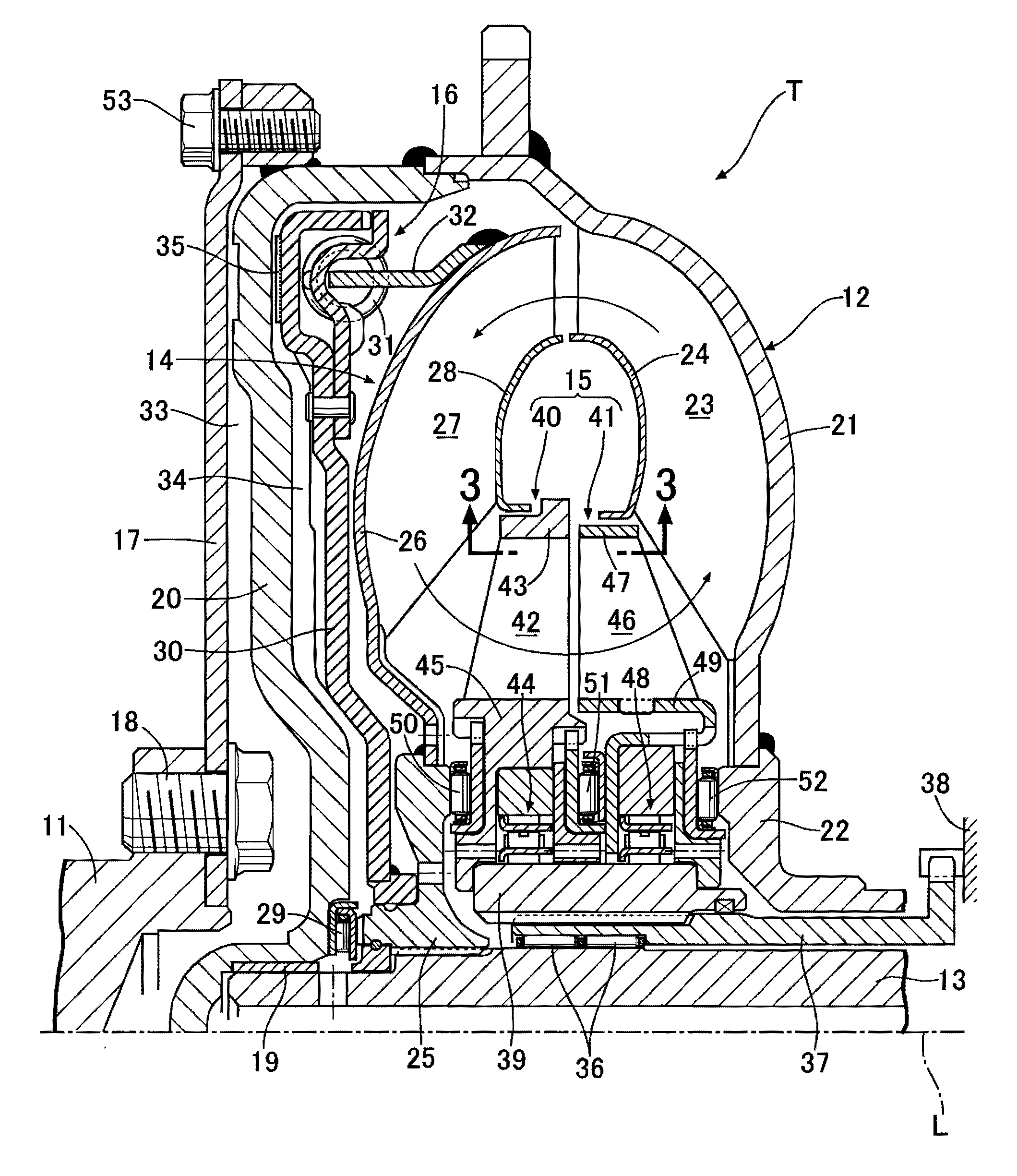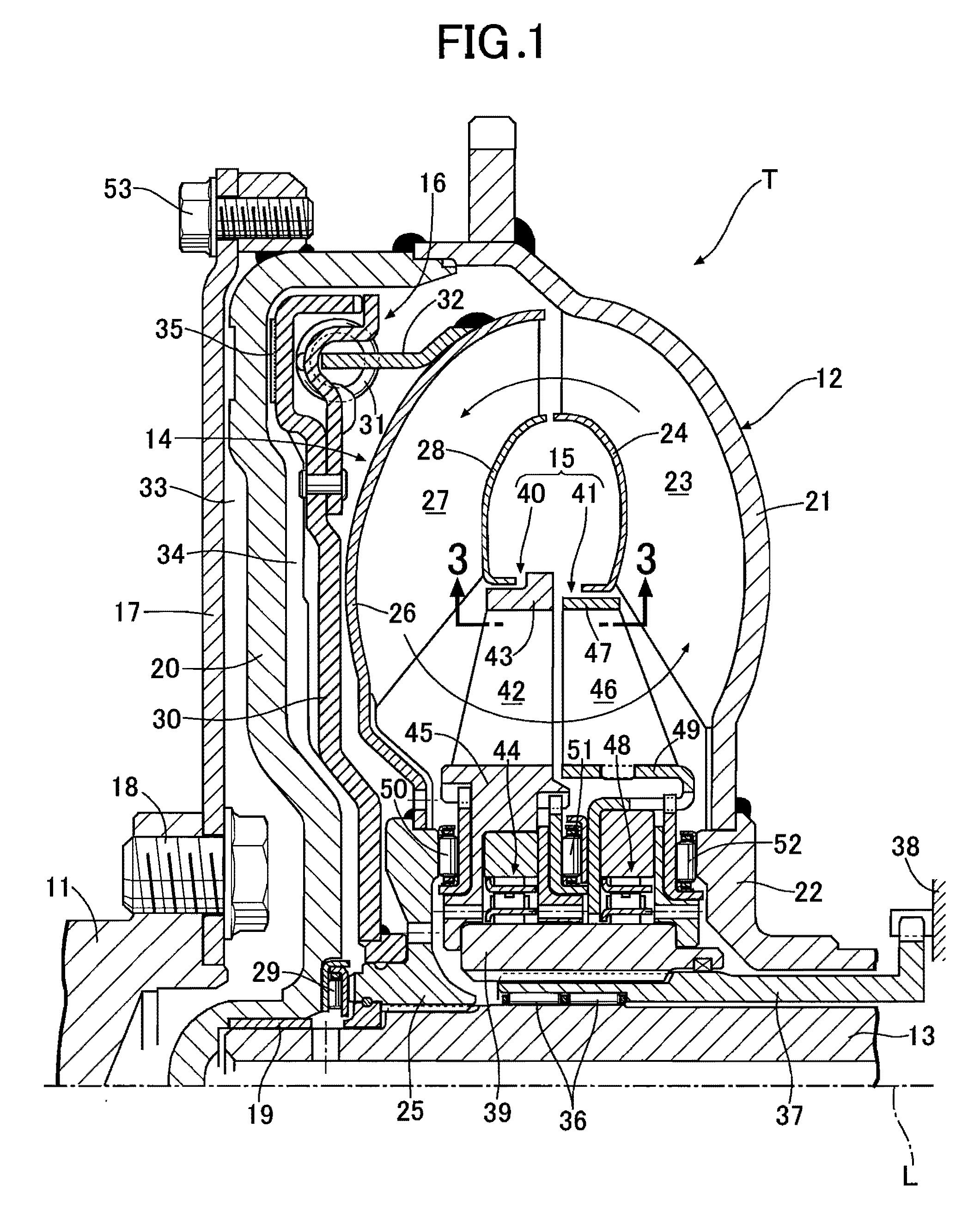Torque converter stator structure
a technology of torque converter and stator, which is applied in the direction of rotary clutches, fluid couplings, gearing, etc., can solve the problem of low capacity coefficient in the high speed ratio region, achieve effective alignment, increase the chord length of the blade, and enhance the effect of aligning the flow of oil
- Summary
- Abstract
- Description
- Claims
- Application Information
AI Technical Summary
Benefits of technology
Problems solved by technology
Method used
Image
Examples
first embodiment
[0047]A first embodiment of the present invention is now explained by reference to FIG. 1 to FIG. 5.
[0048]As shown in FIG. 1, a torque converter T for an automobile includes a pump impeller 12 that is connected to a crankshaft 11 of an engine (not illustrated) as a drive source, a turbine runner 14 that is connected to a main shaft 13 of a transmission (not illustrated), a stator 15 disposed between the pump impeller 12 and the turbine runner 14, and a lockup clutch 16 that can join the pump impeller 12 and the turbine runner 14. The crankshaft 11 and the main shaft 13 are coaxially disposed on an axis L of the torque converter T in a state in which shaft ends thereof oppose each other.
[0049]A plate-shaped drive plate 17 is fixed to the shaft end of the crankshaft 11 by means of bolts 18, and an outer peripheral part of the drive plate 17 is fixed, by means of bolts 53, to an outer peripheral part of a bowl-shaped torque converter cover 20 rotatably supported on the shaft end of the...
second embodiment
[0072]A second embodiment of the present invention is now explained by reference to FIG. 6 to FIG. 8.
[0073]The second embodiment is different from the first embodiment in terms of the shape of second stator blades 46 of a second stator 41, the arrangement otherwise being the same as that of the first embodiment.
[0074]With regard to the second stator blades 46 of the second embodiment, a chord length L2 of a radially outer side portion is larger than a chord length L1 of a radially inner side portion. This enables the flow of oil to be aligned by means of the second stator blades 46 more effectively. If an attempt were to be made to produce the second stator blades 46 with such a shape by die casting, since it would be difficult to carry out release from a mold, the structure of the mold would become complicated, but they can easily be produced by metal plate pressing.
third embodiment
[0075]A third embodiment of the present invention is now explained by reference to FIG. 9 to FIG. 13.
[0076]In the first embodiment, the first stator blades 42 of the first stator 40 have a complete airfoil that has a large blade thickness, and the second stator blades 46 of the second stator 41 have a flat plate-shaped airfoil that has a very small blade thickness, but in the third embodiment the relationship is reversed.
[0077]That is, with regard to a first stator 40, a first stator core 43, a first stator boss 45, and first stator blades 42 are produced separately by press forming a metal plate and they are assembled as a unit by welding. Therefore, the airfoil formed from a leading edge 42a, a trailing edge 42b, a ventral surface 42c, and a dorsal surface 42d of the first stator blade 42 has a flat plate shape having a constant blade thickness that is equal to the plate thickness of the metal plate.
[0078]On the other hand, a second stator 41 is a member that is made by die-castin...
PUM
| Property | Measurement | Unit |
|---|---|---|
| thickness | aaaaa | aaaaa |
| length | aaaaa | aaaaa |
| torque ratio | aaaaa | aaaaa |
Abstract
Description
Claims
Application Information
 Login to View More
Login to View More - R&D
- Intellectual Property
- Life Sciences
- Materials
- Tech Scout
- Unparalleled Data Quality
- Higher Quality Content
- 60% Fewer Hallucinations
Browse by: Latest US Patents, China's latest patents, Technical Efficacy Thesaurus, Application Domain, Technology Topic, Popular Technical Reports.
© 2025 PatSnap. All rights reserved.Legal|Privacy policy|Modern Slavery Act Transparency Statement|Sitemap|About US| Contact US: help@patsnap.com



